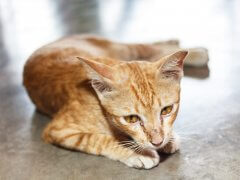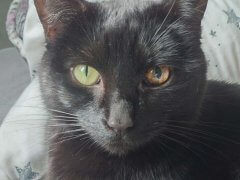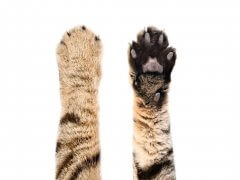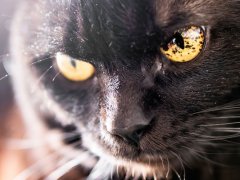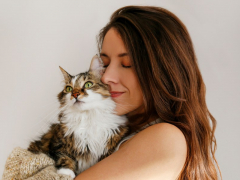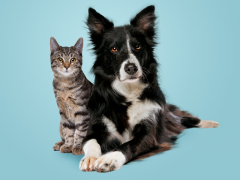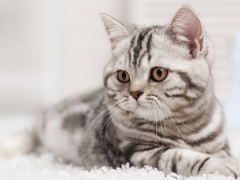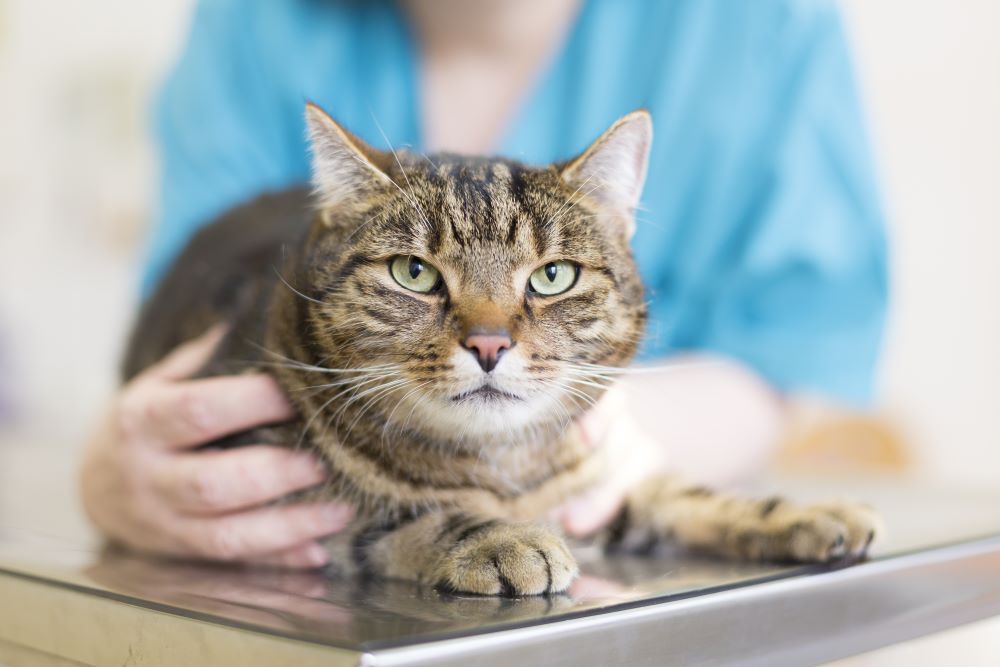
What Is Feline Distemper or Panleukopenia?
Feline Panleukopenia (or Panleucopaenia, to use its UK English spelling), also known as Feline Distemper, is a highly contagious viral disease (i.e. it spreads very easily). The causative virus is named Feline Parvo Virus (FPV) or Feline Panleukopenia Virus.
Quick Overview: Feline Panleukopenia Virus in Cats
 Common Symptoms: Lethargy, depression, vomiting, diarrhea, painful abdomen, poor haircoat quality, weight loss, fever, poor appetite, collapse and bruising of the skin in severe cases.
Common Symptoms: Lethargy, depression, vomiting, diarrhea, painful abdomen, poor haircoat quality, weight loss, fever, poor appetite, collapse and bruising of the skin in severe cases.
 Diagnosis: Fecal testing, bloodwork (low white blood cell count, low red blood cell count), polymerase chain reaction (PCR), antibody levels.
Diagnosis: Fecal testing, bloodwork (low white blood cell count, low red blood cell count), polymerase chain reaction (PCR), antibody levels.
 Requires Ongoing Medication: No
Requires Ongoing Medication: No
 Vaccine Available: Yes. The Feline Viral Rhinotracheitis, Calicivirus and Panleukopenia (FVRCP) combo vaccine. The vaccine is started around 6-8 weeks of age and boostered every 3 weeks until 16 weeks of age. After an annual booster, it can then be boostered every 3 years.
Vaccine Available: Yes. The Feline Viral Rhinotracheitis, Calicivirus and Panleukopenia (FVRCP) combo vaccine. The vaccine is started around 6-8 weeks of age and boostered every 3 weeks until 16 weeks of age. After an annual booster, it can then be boostered every 3 years.
 Treatment Options: Treatment is symptomatic, focusing on addressing vomiting, diarrhea, and dehydration. Antibiotics if secondary bacterial infection is a concern. There is no specific antiviral treatment.
Treatment Options: Treatment is symptomatic, focusing on addressing vomiting, diarrhea, and dehydration. Antibiotics if secondary bacterial infection is a concern. There is no specific antiviral treatment.
 Home Remedies: None
Home Remedies: None
This infection is one of the main diseases included in the routine vaccinations that are given to kittens and cats. In fact, the only good thing about this disease is that it is easy to prevent with vaccinations.
Note: Feline Panleukopenia / Feline Distemper is completely different from several other cat and dog diseases that have names that may sound similar to an inexperienced ear.
Feline Panleukopenia/ Feline Distemper is not to be confused with the following diseases:
- Feline Leukemia Virus (FeLV): the “feline” and “leuk” parts of the disease name sometimes confuse people.
- Feline Immunodeficiency Virus (FIV): again, the “Feline” and “Virus” parts of the name are the only similarities between these diseases.
- Canine Distemper: this dog disease is caused by a different type of virus entirely and is not related in any way to Feline Distemper.
Why Is the Disease Called “Panleukopenia”?
The name of the disease is derived from the Greek language: “Pan” means “all”, “leuko” means “white” and “penia” means “deficiency” or “poverty”.
When you put that together in medical terms, “Panleukopenia” means “deficiency in all types of white blood cells”.
In real life, the disease has been given this name because a key feature of the condition is the significant decrease in the number of white blood cells. The reason for this is that FPV attacks the cat’s immune system and bone marrow.
The most visible effect is the suppression of the cat’s white blood cell count. A low white blood cell count makes infected cats vulnerable to secondary infection by other disease-causing agents that their immune system would normally deal with.
How Do Cats Catch Feline Distemper?
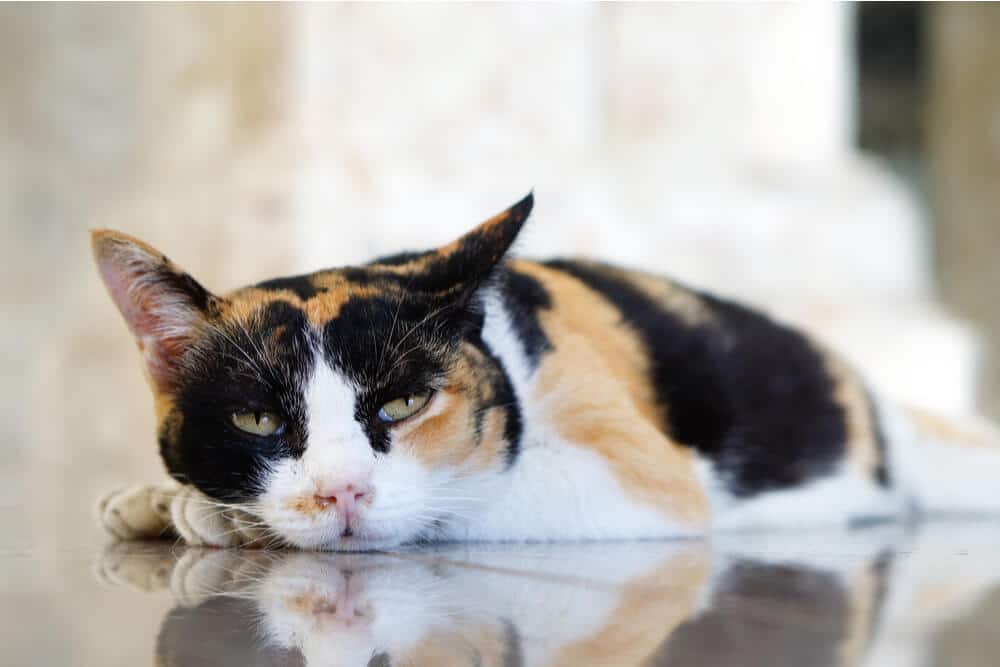
The virus affects the intestinal tract, causing vomiting and diarrhea. These bodily excretions will be loaded with virus particles.
The disease is spread by the oral route i.e. if a cat licks or swallows any virus particles, they will become infected themselves.
So-called “fomites” spread the virus easily. If any physical item is contaminated by the virus, it immediately becomes highly infectious to other cats. Cats can catch the virus from items in the environment, including food dishes, water bowls, litter trays and boxes, bedding, and human hands or clothing.
It’s easy to see how unvaccinated cats in a household, kennels or shelter environment can be easily infected when one cat has the disease.
To make things worse, FPV is a tough virus that can survive for a year or more in the environment. The virus is resistant to many disinfectants, but it is inactivated by certain specific products, including bleach, 4% formaldehyde, 1% glutaraldehyde, and other specific disinfectants used by veterinarians.
The highly contagious nature of the virus combined with its ability to survive in the environment for prolonged periods makes the disease a particular challenge for animal shelters.
What Are the Signs and Symptoms of Feline Panleukopenia?
In some cases, a kitten or cat may be found dead: so-called “peracute” cases. The diagnosis may then be made after a post-mortem examination.
More commonly, so-called “acute” disease is seen.
Affected animals are depressed and inappetant, with vomiting and diarrhea. Bloody diarrhea is sometimes seen, and there may be a nasal discharge. From an owner’s perspective, the fact that their pet is dull and not eating is often the first thing that’s noticed, with the other signs following.
On examination by the veterinarian, they often have pyrexia or high fever (body temperature over 39.7° C or 103.5° F), although in advanced cases of illness, the temperature may fall to subnormal levels. Some cats have abdominal pain, groaning when their abdomens are palpated, and sometimes thickening of the intestines and enlarged lymph nodes can be felt.
Diagnosis of Feline Panleukopenia
The signs shown by the kitten or cat with parvovirus infection are often sufficient to make a presumptive diagnosis; the low white blood cell count on a complete blood count (CBC) brings strong supportive evidence.
Specific tests to identify the virus can be carried out if needed, either by laboratory examination for viral antigen in the faeces or blood or by carrying out blood tests to look for rising antibody levels over a period of days or weeks.
Treatment of Feline Panleukopenia

Fluid therapy is a cornerstone of feline panleukopenia treatment.
There is no specific antiviral medication available for feline panleukopenia, so the main treatment is simple supportive care, aiming to keep the affected animal as comfortable and healthy as possible until their body naturally defeats the virus.
- Fluid therapy is the cornerstone of treatment, replacing fluid lost by vomiting and diarrhea using intravenous or subcutaneous administration of fluids. To describe this colloquially, affected cats are often “put on a drip”.
- Antibiotics are usually administered to prevent secondary bacterial infections from aggravating the cat’s condition. The virus-induced drop in white blood cells means that affected cats are particularly vulnerable to bacterial infections, as their immune system is unable to function normally.
- Vitamin B injections are often given to prevent thiamine (Vitamin B1) deficiency.
- Anti-emetic medication may be given to sick cats that are vomiting repeatedly.
- Blood or plasma transfusions may be given to individuals that become anaemic or that have very low plasma protein levels.
- Rarely, serum from vaccinated cats may be given, as this contains high levels of anti-FPV antibodies. However this is only helpful early in the disease; once signs of illness have developed, it is generally too late for this treatment to have a significant effect.
What Is the Prognosis for Cats With Feline Panleukopenia?
The mortality rate of Feline Panleukopenia is around 50%. If the patient survives the first two or three days, his or her chance of long term survival is much higher.
Prevention of Feline Distemper
Quarantine and Disinfection
In the face of an outbreak, strict isolation of affected cats is essential, along with the meticulous disinfection of all items in the environment with an approved disinfectant.
The virus is shed copiously by infected patients for the first few days of the illness and can continue to be shed for up to six weeks in some cases. For this reason, affected cats need to be kept in isolation for this period of time, even though they may seem to be fully recovered.
Vaccination
Vaccination against FPV is highly effective, providing complete protection in nearly every case. Both modified live and killed virus vaccines are available.
The former is more effective and provides more rapid onset protection, but live virus vaccines should not be used in pregnant cats nor in very young kittens (less than four weeks of age). They can cause developmental brain problems to kittens in utero and to very young animals.
Vaccination against Feline Panleukopenia is part of the standard vaccination protocol for kittens: the first vaccine is usually given at around 8 – 9 weeks of age, with the second and final vaccine given at around 12 weeks of age.
Vaccination protocols vary depending on the specific vaccine used, and it’s best to ask for the advice of your local vet to ensure that your kitten is properly protected. The vaccine against this disease is commonly combined with a vaccine against the two types of Cat Flu: feline herpes virus and feline calicivirus.
Pet owners should always ask their vet precisely what vaccination is being given so that they are clear about what their pet is vaccinated against.
A vaccination booster should be given one year later (when a cat is around 15 months of age) and then every three years for the rest of the cat’s life. Again, it is best to discuss the details of your cat’s booster vaccination plan with your own vet. The feline distemper vaccine cost may cost in the range of $30 to $55.
Frequently Asked Questions
Can a vaccinated cat get panleukopenia?
The vaccine against Feline Panleukopenia is highly effective and vaccinated cats are extremely unlikely to become infected by the virus. However, in the face of active infection, no vaccine is 100% effective, and vaccine failure is possible in a very low percentage of cats.
Can adult cats get panleukopenia?
If an adult cat is not vaccinated, then there is a serious risk of infection if they are exposed to the Feline Panleukopenia Virus either in the environment or by meeting an infected cat. Similarly, if older cats have not had a booster vaccination for over three years, there is a risk that they may develop the disease.
Can dogs get Feline Panleukopenia?
FPV can infect dogs but does not make them visibly ill. However, the well-known Canine Parvovirus, the cause of devastating disease in unvaccinated dogs, originated back in the 1970s as a mutation of Feline Parvovirus.
These diseases are life-threatening in their own species, while barely affecting animals of other species. Unvaccinated dogs often die of Canine Parvovirus, while unvaccinated cats commonly die of Feline Parvovirus/ Panleukopenia.
Is this a disease that cat owners should be afraid of?
Not at all. This disease is completely preventable by vaccination. As long as you follow your veterinarian’s advice on vaccination of your pet, you do not need to worry about this illness.
